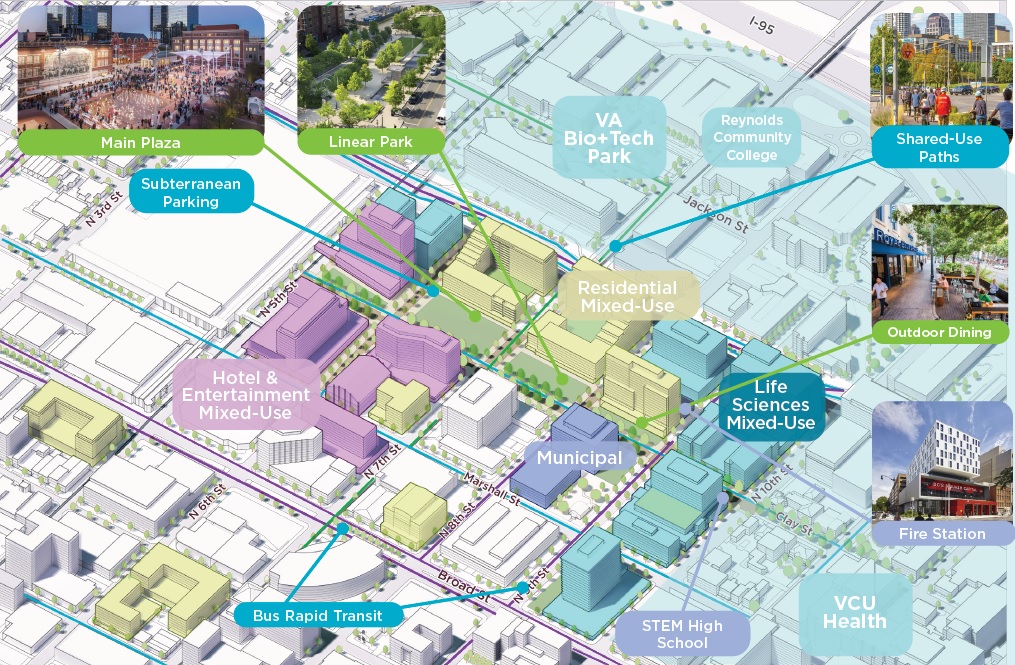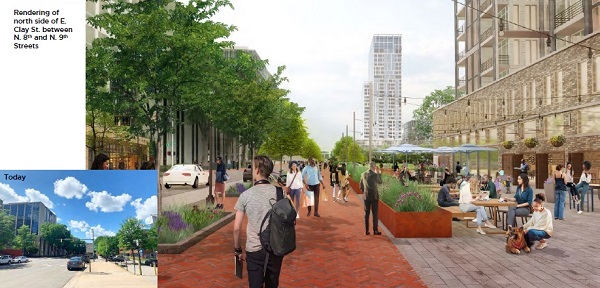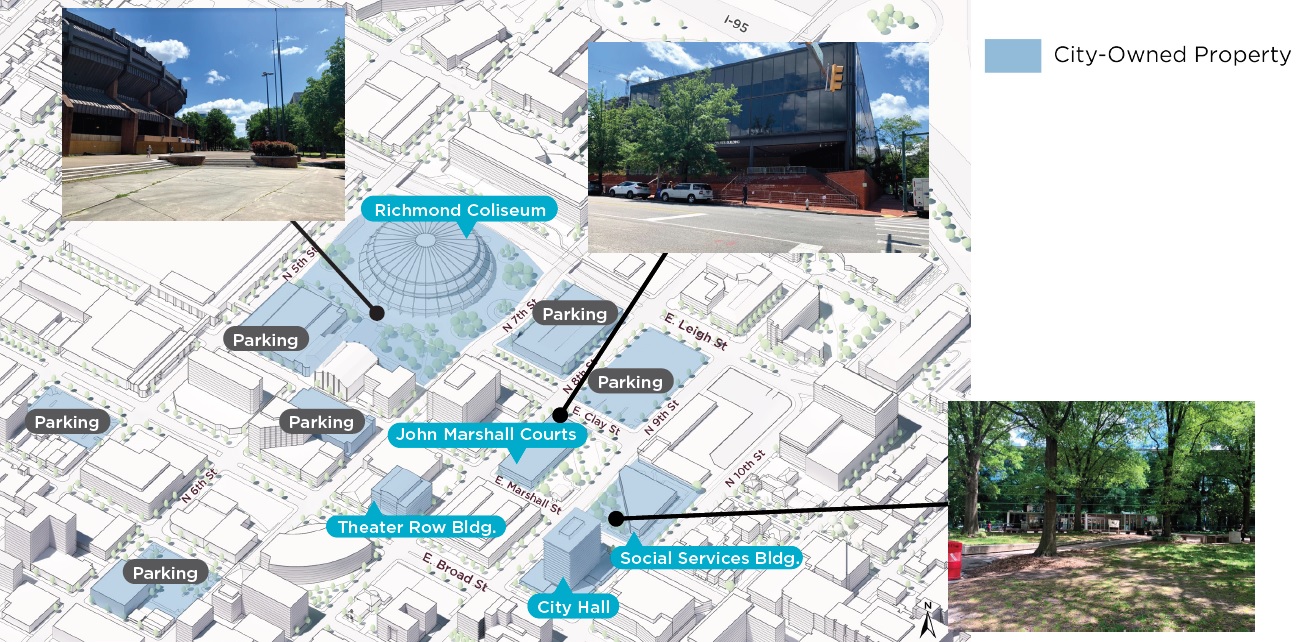
A conceptual map of the city blocks and properties involved in the city’s City Center plan and their potential uses. (Images courtesy of the City of Richmond)
The repositioning of a swath of downtown that for decades has been defined by the Richmond Coliseum is headed for its next step.
Richmond officials are moving forward with a proposal to update the zoning of the 20-block area referred to as City Center. The zoning change would be in alignment with the City Center Innovation District Small Area Plan, a future land-use plan that was adopted in January.
The plan is aimed at guiding growth and redefining the area that’s slated to lose the wrecking-ball-bound Coliseum, a 50-year-old arena that’s planned to be demolished. The plan envisions the area as a so-called innovation district, a concept aimed at encouraging development that would feed off and enhance existing anchors such as the VA Bio+Tech Park and VCU Health.
The proposed zoning changes would set the stage for such growth, as well as expected solicitations for the sale and redevelopment of the city-owned properties, which make up the bulk of the 26-acre area.
The changes would potentially consolidate existing designations into a new zoning category that would allow for a greater mix of uses, including residential uses and street-fronting commercial spaces.
The new zoning category would be a reworked version of the city’s RP Research Park district that currently makes up the biotech park properties. The changes would add residential, hotel and school use to the district.
Existing zoning in City Center is primarily B-4 Central Business District, RO-3 Residential-Office District and zoning specific to the Coliseum, biotech park and the Greater Richmond Convention Center.
The changes would also allow for unlimited building height and density, a move away from the “inclined plane” approach to determining height limits in B-4.

A rendering of how development could look facing north from Clay Street between Eighth and Ninth streets under the city’s City Center plan.
Presentations on the proposed changes note that recently constructed state-owned buildings, such as the new 14-story General Assembly Building and VCU Health’s 17-story Adult Outpatient Pavilion were exempt from the city requirement, which calls for 4 feet in height for every 1 foot in width from the center of adjacent right-of-way.
Other changes are aimed at bringing City Center in line with the future land-use recommendations of the Richmond 300 master plan, which splits the area between “Downtown Mixed-Use” on the western half and institutional use on the eastern half.
Also proposed is a requirement that at least 1,000 square feet and as much as one-third of the floor area of the ground floor of a residential building be used as street-oriented commercial space, aimed at encouraging activity along city streets. Floor area bonuses would also be permitted for any development that includes building setbacks or features such as a pedestrian plaza, open walkway or enclosed parking.
The proposal was presented to the Planning Commission last week. Planners held an initial public meeting this month and are scheduled to hold a second meeting May 11 at 6 p.m. The link for that online meeting and additional information can be found here.
The city is also conducting a survey that ends April 27. The survey can be taken here.

A conceptual map of the city blocks and properties involved in the city’s City Center plan and their potential uses. (Images courtesy of the City of Richmond)
The repositioning of a swath of downtown that for decades has been defined by the Richmond Coliseum is headed for its next step.
Richmond officials are moving forward with a proposal to update the zoning of the 20-block area referred to as City Center. The zoning change would be in alignment with the City Center Innovation District Small Area Plan, a future land-use plan that was adopted in January.
The plan is aimed at guiding growth and redefining the area that’s slated to lose the wrecking-ball-bound Coliseum, a 50-year-old arena that’s planned to be demolished. The plan envisions the area as a so-called innovation district, a concept aimed at encouraging development that would feed off and enhance existing anchors such as the VA Bio+Tech Park and VCU Health.
The proposed zoning changes would set the stage for such growth, as well as expected solicitations for the sale and redevelopment of the city-owned properties, which make up the bulk of the 26-acre area.
The changes would potentially consolidate existing designations into a new zoning category that would allow for a greater mix of uses, including residential uses and street-fronting commercial spaces.
The new zoning category would be a reworked version of the city’s RP Research Park district that currently makes up the biotech park properties. The changes would add residential, hotel and school use to the district.
Existing zoning in City Center is primarily B-4 Central Business District, RO-3 Residential-Office District and zoning specific to the Coliseum, biotech park and the Greater Richmond Convention Center.
The changes would also allow for unlimited building height and density, a move away from the “inclined plane” approach to determining height limits in B-4.

A rendering of how development could look facing north from Clay Street between Eighth and Ninth streets under the city’s City Center plan.
Presentations on the proposed changes note that recently constructed state-owned buildings, such as the new 14-story General Assembly Building and VCU Health’s 17-story Adult Outpatient Pavilion were exempt from the city requirement, which calls for 4 feet in height for every 1 foot in width from the center of adjacent right-of-way.
Other changes are aimed at bringing City Center in line with the future land-use recommendations of the Richmond 300 master plan, which splits the area between “Downtown Mixed-Use” on the western half and institutional use on the eastern half.
Also proposed is a requirement that at least 1,000 square feet and as much as one-third of the floor area of the ground floor of a residential building be used as street-oriented commercial space, aimed at encouraging activity along city streets. Floor area bonuses would also be permitted for any development that includes building setbacks or features such as a pedestrian plaza, open walkway or enclosed parking.
The proposal was presented to the Planning Commission last week. Planners held an initial public meeting this month and are scheduled to hold a second meeting May 11 at 6 p.m. The link for that online meeting and additional information can be found here.
The city is also conducting a survey that ends April 27. The survey can be taken here.

Why are renderings always populated by dozens of people? This one is missing usual child carrying balloons but I’d rather see the actual space with one or two people added for scale than an imaginary lunch hour where everyone is eating outside on a beautiful day.
But does it have the requisite person looking down at their mobile device? That’s what I always look for.
Oddly in Tokyo the bulk of the city streets were very empty due to the low car population.
The only real place were it was wall to wall people like this was the Ginza district in Tokyo were all the heavy tourist shopping was done.
But this scene lacks someone in a fur suit.